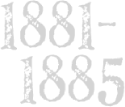The website has been designed and written for a general audience as well as for teachers and students at the primary, middle and secondary school levels. Visitors can learn about important events in Chinese Canadian history and gain a better understanding of the role that Chinese Canadians played in helping build Confederation and a modern Canada. Visitors will also learn that Canada's current position on diversity has evolved out of a more exclusionary past.
The website provides teachers with lesson plans, resources that include primary source documents and first-person narratives, and links to additional research material, all of which can be integrated into classroom teaching and adapted to a variety of grade levels and subject areas. Materials are downloadable as PDF documents, which can be printed for use as required.
Two investigation pathways are offered in the website:
- Explore the oral histories of the railroad worker descendants by listening to
audio segments, viewing image galleries, and reading biographical summaries. This
path utilizes the affinity that students have with digital media usage.
- Explore topics thematically. Each of the six themes in the website can be entry points into curriculum areas such as Social Studies and Canadian History. The streams are enriched with image galleries and a timeline, which help to engage students as well as to provide context.
On June 22, 2006, Prime Minister Stephen Harper offered a full apology in the House of Commons to Chinese Canadians for more than six decades of legislated discrimination, first through Head Tax payments and later, the Chinese Exclusion Act. Since the official apology, understanding the role of Chinese Canadians within the historical record of Canada has gained importance for all Canadians.
Between 1881 and 1885, thousands of Chinese men came to Canada to work as labourers on the construction of the western section of the transcontinental railroad. Today, many Chinese Canadians are direct descendants of these men. The Ties That Bind: Building the CPR, Building a Place in Canada tells their story, and how their forebears contributed to nation building.
The website documents individual and family experiences that shaped the Chinese Canadian community through the generations. The memories and stories that have been collected will be used to educate future generations about the Chinese in Canada.
The Ties That Bind: Building the CPR, Building a Place in Canada is a project of the Foundation to Commemorate the Chinese Railroad Workers in Canada (FCCRWC) in partnership with the Multicultural History Society of Ontario and the Canadian government through the Citizenship and Immigration Canada’s Community Historical Recognition Program (CHRP).
The Ties That Bind: Building the CPR, Building a Place in Canada website has two inter-related sections. The first section focuses on the oral histories of the descendants of the railway workers and their family memories. The second section provides a historical overview of the railway building period, and the years that followed, up to the time of the official apology by Prime Minister Harper and the Canadian government.
The oral history section tells stories about identity and what it means to be Canadian despite a historical record that details a stream of racist obstacles. The descendants talk about: arrival and settlement; migration across Canada; the challenges of racism and government anti-Chinese policies; family ties and reunification; contributing to the Canadian economy through entrepreneurship, and their place in Canada today.
The historical section is divided into six thematic streams. At any point, teachers or students can move between the streams. Depending on the grade level and the activity, some streams may be more relevant than others. Content links to key points are provided throughout the site. Image galleries and audio and video clips enhance the learning and experiential opportunities in the website.
The lesson plans can be utilized in Social Studies curriculums (themes – i.e. identity, culture and society, etc.) and in History curriculums (themes – i.e. Canadian history, immigration, nation building, Canadian expansion, etc.)
Teachers will be able to promote critical thinking skills and make connections to language-based activities and other interdisciplinary extensions.
Three lesson plans are available for classroom use. Each lesson plan is a stand-alone unit. The units come complete with instructions and support material. All can be downloaded as PDF documents.
Unit 1 – Primary Source Documents and Visual Literacy
Students analyze primary source material from The Ties That Bind website using objective observation, deductive observation, and facts recording. The unit helps students develop visual literacy skills, critical thinking skills, analytical skills, and a deeper understanding of the Chinese Canadian experience in Canada.
Students will use the oral histories in The Ties That Bind website as a starting point for researching their own family social history in Canada. They will take on the role of social historian and interview a family member. The unit teaches students how to conduct an interview and how to analyze and interpret the information collected.
Students use The Ties That Bind website to research the experiences of the Chinese who came to Canada in the 1880s to work as labourers on the CPR, and the experiences of their descendants. Students will learn about Chinese railroad workers, the type of work they did on the railway, and what their lives were like after the railway was completed and they were no longer needed. Interviews contributed by descendants fill in blanks in the Canadian historical record and provide valuable information on the families of the workers and their contributions to Canada, despite systemic discrimination.
-
 Alexandria Sham1h21m42s
Alexandria Sham1h21m42s -
 Brian Joe1h01m48s
Brian Joe1h01m48s -
 Larry Kwong1h20m04s
Larry Kwong1h20m04s -
 James Pon0h17m01s
James Pon0h17m01s -
 Judi Michelle Young1h17m24s
Judi Michelle Young1h17m24s -
 Ronald Lee1h34m33s
Ronald Lee1h34m33s -
 Kevan Jangze0h54m20s
Kevan Jangze0h54m20s -
 Stan Fong1h20m36s
Stan Fong1h20m36s -
 Cindy Leong1h06m35s
Cindy Leong1h06m35s -
 David Wong0h45m26s
David Wong0h45m26s -
 Kwoi Gin0h39m44s
Kwoi Gin0h39m44s -
 David Chu0h38m23s
David Chu0h38m23s -
 Landy Ing-Anderson0h45m57s
Landy Ing-Anderson0h45m57s

















